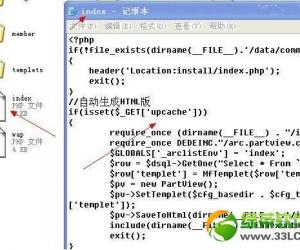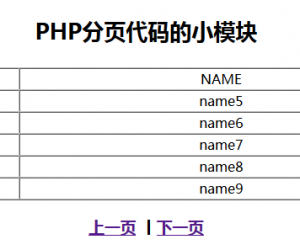分页的思路以及在ZF中的使用
发布时间:2015-05-27 19:34:19作者:知识屋
分页思路:
只需要得到两个变量就成功了一半:
1. 每页要显示的记录数$pageSize
2. 表中总的数据量 $rowCount
有了以上两个变量,我们就可以得出 共有几页了$pageCount
然后通过for循环,比如总共有13个页面,那么很容易就能通过for循环输出页数
$nav='';//用来保存页数的一个变量
for ($i=1;$i<=13;$i++)
{
$nav.="<a href='index.php?page=".$i."'>第".$i."页</a> ";
}
以上的for循环将输出如
第1页,第2页,第3页,第4页,第5页,第6页,第7页,第8页,第9页,第10页,第11页,第12页,第13页
如果我们只想每次只显示十个页面呢?比如1-10页,11-20页
很简单,只要稍微修改下for循环即可实现
$step= floor(($pageNow-1)/10)*10+1;
for ($i=$step;$i<=$step+10;$i++)
{
$nav.="<a href='index.php?page=".$i."'>第".$i."页</a> ";
}
比如,当前页面$pageNow如何在1~10之间的话,那么$step=0
当前页面$pageNow如何在11~20之间的话,那么$step=10
当前页面$pageNow如何在21~30之间的话,那么$step=20
参考具体的实现过程的代码,我们不难发现,for循环的第二个条件只需要加上10就可以实现每次只显示10也的情况了,我们将这一步分装在fenyePage类中的getLink()方法中
话又说回来,如何才能得到$pageSize和$rowCount两个变量的值呢?
$pageSize可以又程序员自己指定,$rowCount可以借助一个简单的执行sql语句的函数就能得到
1 <?php
2 /**
3 * $sql语句:①获取数据②获取总记录数
4 */
5 class fenyePage{
6 public $pageSize=5;//每页显示的数量-->程序员指定的
7 public $rowCount;//这是从数据库中获取的(形如SELECT COUNT(id) FROM TABLE)用来保存总共有多少条记录
8 public $pageNow;//通过$_GET['page']获取的,用来保存当前所在的页码
9 public $pageCount;//计算得到的,用来保存总共有多少页
10 public $res_arr;//用来保存要显示到页面的数据(比如保存SELECT * FROM TABLE LIMIT 0,10 检索的数据)
11 public $nav;//显示第几页第几页的导航条
12
13 /**
14 * 取得当前页面的超链接
15 *
16 * @author 小飞 2012/5/30
17 */
18 public function getLink()
19 {
20 $this->nav='';
21 $this->pageCount=ceil(($this->rowCount/$this->pageSize));
22 $step= floor(($this->pageNow-1)/10)*10+1;
23 if ($this->pageNow>10)
24 {
25 $this->nav.=" <a href='index.php?page=".($step-1)."'> << </a> ";//整体每10页向前翻
26 }
27 if ($this->pageNow!=1)
28 {
29 $this->nav.="<a href='index.php?page=".($this->pageNow-1)."'> 上一页</a> ";
30 }
31 if ($this->pageNow!=1)
32 {
33 $this->nav.="<a href='index.php?page=1'>首页</a> ";
34 }
35 for ($start=$step;$start<$step+10 && $start<=$this->pageCount;$start++)
36 {
37 $this->nav.="<a href='index.php?page=".$start."'>".$start."</a> ";
38 }
39 if ($this->pageNow!=$this->pageCount)
40 {
41 $this->nav.="<a href='index.php?page=".$this->pageCount."'>末页</a> ";
42 }
43 if ($this->pageNow!=$this->pageCount)
44 {
45 $this->nav.=" <a href='index.php?page=".($this->pageNow+1)."'>下一页</a>";
46 }
47 if ($this->pageCount>10 && $this->pageNow<$this->pageCount-8){
48 $this->nav.=" <a href='index.php?page=".($step+10)."'> >> </a>";//整体每10页向后翻
49 }
50 $this->nav.="/共有".$this->pageCount."页";
51 }
52 }
53 ?>
由于zf中操作数据库的任务由model层来完成,所以,我将获取$rowCount的值的函数放在了对应的表model中
比如:我是操作order表的
那么当我要显示所有订单信息的时候,我通过order类中的showorder()方法取得$rowCount的值,并将其付给分页类中的$rowCount属性
同样,将要显示在页面上的数据信息也一并付给了分页类中的$res_arr属性
这样,我们就可以很容易的通过实例化一个分页类(fenyePage),然后将其通过参数传给showorder()函数,由该函数完成以下动作:
①要显示在页面上的信息
②表中总共有多少条记录
1 /**
2 * 根据指定的用户id,查询该用户的历史订餐记录
3 *
4 * @author 小飞 2012/5/30
5 * @param $id 用户id
6 * @param $fenye 实例化的一个对象,用来处理分页
7 * @todo $sql1语句 "select * from table where * limit 0,10" 该sql语句主要用来检索数据库中的数据,用以显示在view层
8 * @todo $sql2语句 "select count(id) from table" 该sql语句用来得出总的数据量
9 */
10 public function showorder($id=null,$fenye=null)
11 {
12 $db = $this->getAdapter();
13
14 $select=$db->select();
15 $select->from(array('o' => 'order'),array('o.id','o.user_id','o.user_name','o.food_name','o.food_price','o.order_time','o.order_state'));
16 if ($id!=null){
17 $select->where('o.user_id=?',$id);
18 }
19 $select->join(array('d'=>'department'),'o.dep_id = d.id','d.dep_name');
20 if($fenye!=null){
21 $select->limit($fenye->pageSize,($fenye->pageNow-1)*$fenye->pageSize);
22 }
23 $sql1=$select->__toString();
24 //该sql语句主要用来计算总的数据量
25 $sql2="SELECT COUNT(id) FROM `order`";
26 $fenye->res_arr=$db->fetchAll($sql1);//将要显示的数据存储到分页类的$res_arr属性当中,方便调用
27 $rowCount=$db->fetchAll($sql2);//将表中的总数据量保存到分页类的rowCount属性当中
28 $fenye->rowCount=$rowCount[0]['COUNT(id)'];
29 $fenye->getLink();
30 return $fenye->res_arr;
31 }
至此,分页类的功能就已经实现了
摘自 WEB开发_小飞
相关知识
-
如何对PHP文件进行加密方法 PHP实现加密的几种方式介绍
-
php生成圆角图片的方法 电脑中php怎么生成圆角图片教程
-
用PHP构建一个留言本方法步骤 php怎么实现留言板功能
-
php中三元运算符用法 php中的三元运算符使用说明
-

php文件如何怎么打开方式介绍 php文件用什么打开方法
-
PHP怎么插入数据库方法步骤 php编程怎么导入数据库教程
-
如何安装PHPstorm并配置方法教程 phpstorm安装后要进行哪些配置
-
PHP 获取远程文件大小的3种解决方法 如何用PHP获取远程大文件的大小
-
20个实用PHP实例代码 php接口开发实例代码详细介绍
-
如何架设PHP服务器方法步骤 怎么搭建php服务器简单教程





















